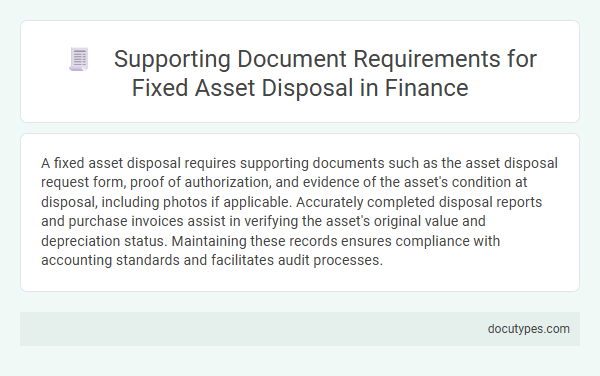A fixed asset disposal requires supporting documents such as the asset disposal request form, proof of authorization, and evidence of the asset's condition at disposal, including photos if applicable. Accurately completed disposal reports and purchase invoices assist in verifying the asset's original value and depreciation status. Maintaining these records ensures compliance with accounting standards and facilitates audit processes.
Introduction to Fixed Asset Disposal in Finance
Fixed asset disposal is a critical process in finance involving the removal of long-term assets from a company's books. Proper documentation ensures accurate accounting and compliance with regulatory standards during the disposal. You need specific supporting documents to validate the transaction and update financial records appropriately.
Importance of Supporting Documents in Asset Disposal
Supporting documents for fixed asset disposal include asset disposal forms, approval records, and proof of sale or transfer. These documents ensure compliance with accounting standards and facilitate accurate financial reporting. You must maintain thorough documentation to validate the disposal transaction and support audit requirements.
Common Types of Fixed Asset Disposal
Fixed asset disposal requires specific supporting documents to ensure accurate financial reporting and compliance. Common types include sale, trade-in, donation, and scrapping of assets.
For a sale, you need a sales invoice and receipt to confirm the transaction. Trade-in requires documentation of both the old and new asset values along with the trade-in agreement. Donations or scrapping require authorization forms and asset removal records to verify the disposal process.
Key Supporting Documents Needed for Asset Disposal
| Key Supporting Documents | Description |
|---|---|
| Disposal Authorization Form | Official approval document signed by authorized personnel to authorize the asset disposal process. |
| Asset Disposal Request | Formal request detailing the asset to be disposed of, including asset ID, description, and reason for disposal. |
| Fixed Asset Register Update | Record showing removal or status change of the asset in the fixed asset register after disposal. |
| Disposal Agreement or Sale Invoice | Contract or invoice documenting sale or transfer of ownership if the asset is sold or given away. |
| Asset Valuation Reports | Appraisals or valuation documents supporting the asset's value at the time of disposal. |
| Proof of Physical Disposal | Evidence such as photos or certificates confirming the physical destruction or removal of the asset. |
| Accounting and Journal Entries | Records of financial entries reflecting asset disposal in the company's accounting system. |
| Tax and Regulatory Compliance Documents | Documents ensuring compliance with local tax laws and regulatory requirements related to asset disposal. |
Fixed Asset Disposal Approval Forms
Fixed asset disposal requires specific supporting documents to ensure compliance and accurate record-keeping. One of the most critical documents is the Fixed Asset Disposal Approval Form, which authorizes the removal of the asset from the company's books.
This form captures essential details such as asset identification, reason for disposal, and approval signatures from relevant management. You must submit this document to maintain transparency and validate the asset disposal process within your finance department.
Asset Valuation and Appraisal Reports
What supporting document is needed for fixed asset disposal to verify its value? Asset valuation and appraisal reports are essential for accurately determining the current worth of the asset. Your financial records must include these documents to ensure compliance and transparency during disposal.
Disposal Method Justification Documentation
When disposing of fixed assets, thorough documentation of the disposal method is essential. Disposal method justification documentation provides clear evidence supporting the chosen approach, whether it is sale, donation, abandonment, or trade-in.
This documentation ensures compliance with accounting standards and internal controls. You must include detailed explanations, approvals, and valuations that validate the disposal method selected for audit and record-keeping purposes.
Third-Party Sales and Transfer Agreements
Proper documentation is essential when disposing of fixed assets, especially involving third-party sales and transfers. These records ensure transparent financial reporting and compliance with accounting standards.
- Third-Party Sales Agreement - This document outlines the terms, conditions, and sale price agreed upon between the seller and the external buyer of the fixed asset.
- Transfer Agreement - A legal contract detailing the transfer of ownership from one party to another, applicable in internal asset transfers or external agreements.
- Proof of Payment - Receipts or bank statements confirming the transaction amount is received, validating the completion of the sale or transfer.
Recordkeeping and Audit Compliance Requirements
Proper documentation is essential for fixed asset disposal to ensure accurate recordkeeping and audit compliance. Supporting documents validate the transaction and help maintain transparency within financial records.
- Disposal Authorization - Official approval from management confirming the asset's removal from company records is required.
- Asset Disposal Form - Detailed form specifying asset information, disposal method, and reason ensures accurate tracking.
- Supporting Evidence - Receipts, sale agreements, or destruction certificates provide proof of disposal and financial impact.
Maintaining these documents safeguards against errors and facilitates adherence to audit standards and regulatory requirements.
What Supporting Document Is Needed for Fixed Asset Disposal? Infographic

